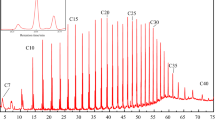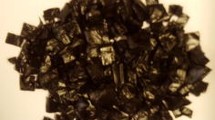Abstract
Polyethylene is widely used due to its excellent properties. However, the growing demand and higher production of polyethylene have also brought new types of hazards. It is essential to study the pyrolysis of polyethylene for the polyethylene process conditions and the prevention of polyethylene dust explosion. In this paper, the pyrolysis of linear low-density polyethylene (LLDPE) and high-density polyethylene (HDPE) under different heating rates in N2 and different ethylene concentration was studied by the TG-DSC method. The pyrolysis kinetics of polyethylene was analyzed by using Li Chung-Hsiung thermal analysis method, and the pyrolysis characteristic and reaction kinetics parameters of LLDPE and HDPE were found. The research results show that the increase in the heating rate is beneficial to polyethylene pyrolysis in nitrogen. The temperature at the highest rate increases linearly with the heating rate. The rise of ethylene concentration has some inhibitory effect on the pyrolysis reaction of polyethylene, and ethylene has a significant impact on the polyethylene pyrolysis rate. We also found the most suitable mechanism function of polyethylene pyrolysis from the 12 considered mechanism functions. HDPE pyrolysis stability is higher than LLDPE in nitrogen, while LLDPE pyrolysis stability is higher than HDPE in ethylene.




Similar content being viewed by others
References
Pang L, Zhao Y, Yang K, Sun S, Lv P. Explosion sensitivity test of low density polyethylene dust cloud. Fire Sci Technol. 2019;038:1211–5.
Ma R, Gao J, Yang K, Lv P, Pang L. Research progress of polyethylene dust explosion. China Powder Sci Technol. 2017;23:59–63.
Tan F. Hazard analysis and countermeasures for polyolefin dust explosion. Petrochem Saf Environ Prot Technol. 2005;6:21–24, 58.
Pang H. Demonstration of safety of LLDPE plant powder conveying system. Refin Chem Ind. 2004;015:4–7.
Guan S. Analysis on causes and prevention of “2.23” blasting accident in Liaohua. Fire Sci Technol. 2002;21:83.
Jiao T. Cause analysis and countermeasures of explosion in granular analysis bin of LDPE device. China Synth Resin Plast. 2009;26:47–9.
Gan B, Li B, Jiang H, Zhang D, Bi M, Gao W. Ethylene/polyethylene hybrid explosions: part 1. Effects of ethylene concentrations on flame propagations. J Loss Prev Process Ind. 2018;54:93–102.
Melo PMA, Macêdo OB, Barbosa GP, Ueki MM, Silva LB. High-density polyethylene/mollusk shell-waste composites: effects of particle size and coupling agent on morphology, mechanical and thermal properties. J Mater Res Technol. 2019;8:1915–25.
Zhou R, Mu J, Sun X, Ding Y, Jiang J. Application of intumescent flame retardant containing aluminum diethyphosphinate, neopentyl glycol, and melamine for polyethylene. Saf Sci. 2020;131:104849.
Salasinska K, Mizera K, Celiński M, Kozikowski P, Borucka M, Gajek A. Thermal properties and fire behavior of polyethylene with a mixture of copper phosphate and melamine phosphate as a novel flame retardant. Fire Saf J. 2020;115:103137.
Rijal B, Klipfel F, Dez I, Colin J, Bazin P, Arethuse F, et al. Effect of metal oxides on the thermal degradation of polychloroprene and chlorosulfonated polyethylene. Polym Degrad Stab. 2019;159:90–7.
Khedri S, Elyasi S. Determination of the heat of pyrolysis of HDPE via isothermal differential scanning calorimetry. J Therm Anal Calorim. 2018;131:1509–15.
Alonso A, Lázaro M, Lázaro P, Lázaro D, Alvear D. LLDPE kinetic properties estimation combining thermogravimetry and differential scanning calorimetry as optimization targets. J Therm Anal Calorim. 2019;138:2703–13.
Coelho A, Fonseca IM, Matos I, Marques MM, Botelho do Rego AM, Lemos MANDA, et al. Catalytic degradation of low and high density polyethylenes using ethylene polymerization catalysts: kinetic studies using simultaneous TG/DSC analysis. Appl Catal A Gen. 2010;374:170–9.
Ueno T, Nakashima E, Takeda K. Quantitative analysis of random scission and chain-end scission in the thermal degradation of polyethylene. Polym Degrad Stab. 2010;95:1862–9.
Zhang Y, Wang L, Sun D, Lu X. Experimental study on pyrolysis of low density polyethylene. J Solid Rocket Technol. 2006;29:443–5.
Dong P, Yin S, Bie R. Study on pyrolysis of typical plastics. J Harbin Inst Technol. 2006;38:1959–62.
Li H, Liu L, Zhang H, He Y. Comparative study on thermal decomposition kinetics of HDPE, LLDPE and LDPE. J Jiaying Univ. 2010;28:56–60.
Ceamanos J, Mastral JF, Millera A, Aldea ME. Kinetics of pyrolysis of high density polyethylene. Comparison of isothermal and dynamic experiments. J Anal Appl Pyrol. 2002;65:93–110.
Liu Y, Ma X, Chen D, Zhao L, Zhou G. Co-pyrolysis characteristics and kinetic analysis of typical components of waste plastics. Proc Chin Soc Electr Eng. 2010;30:56–61.
Shi Y, Ma X, Chen D, Zhou G. Effect of heating rate on pyrolysis of waste plastics. Energy Conserv Technol. 2011;29:199–203.
Gascoin N, Navarro-Rodriguez A, Gillard P, Mangeot A. Kinetic modelling of high density polyethylene pyrolysis: part 1. Comparison of existing models. Polym Degrad Stab. 2012;97:1466–74.
Gascoin N, Navarro-Rodriguez A, Fau G, Gillard P. Kinetic modelling of high density polyethylene pyrolysis: part 2. Reduction of existing detailed mechanism. Polym Degrad Stab. 2012;97:1142–50.
Li B, Gu Y, Yan J, Xu X, Chi Y, Jiang X, et al. Study on pyrolysis kinetic model of typical components of municipal solid waste. Acta Sci Circumstantiae. 1999;05:3–5.
Li C-H. An integral approximation formula for kinetic analysis of nonisothermal TGA data. AIChE J. 1985;31:1036–8.
Shen X. Differential thermal, thermogravimetric analysis and non-isothermal solid-phase reaction kinetics. Beijing: Metallurgical Industry Press; 1995.
Acknowledgements
We gratefully acknowledge the financial support provided by the 2019 Yankuang Science and Technology project (Grant No. YKZB 2020-173), the Key Research and Development Program of Shandong Province (Grant No. 2019JZZY020502), and the Science and Technology Project of Qingdao Livelihood (Grant No. 19-6-1-96-nsh).
Author information
Authors and Affiliations
Corresponding author
Ethics declarations
Conflict of interest
The authors declare that they have no conflict of interest.
Additional information
Publisher's Note
Springer Nature remains neutral with regard to jurisdictional claims in published maps and institutional affiliations.
Rights and permissions
About this article
Cite this article
Bai, M., Liu, Y., Liu, L. et al. Kinetics of polyethylene pyrolysis in the atmosphere of ethylene. J Therm Anal Calorim 144, 383–391 (2021). https://doi.org/10.1007/s10973-021-10640-6
Received:
Accepted:
Published:
Issue Date:
DOI: https://doi.org/10.1007/s10973-021-10640-6




